


Lolo National Forest, Montana
August-September, 2000
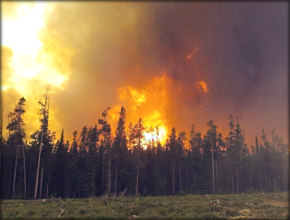 The summer of 2000 brought some of the worst wildfire
conditions the western United States had seen in the last 100 years. The National Interagency Fire Center requested assistance from the Department of Defense; DOD, in turn, tasked Joint Forces Command for troop assistance.
The summer of 2000 brought some of the worst wildfire
conditions the western United States had seen in the last 100 years. The National Interagency Fire Center requested assistance from the Department of Defense; DOD, in turn, tasked Joint Forces Command for troop assistance.
 On 13 August 2000, as had happened in July 1994, the 20th Engineers were given a short-notice mission to deply to the northwest US for front-line firefighting duties. The battalion headquarters, commanded by Lieutenal Colonel James Shumway, formed the nucleus of a 568-man task force (Task Force Lumberjack) consisting of the 20th Engineers; 2nd Battalion, 8th
Cavalry; 1st Battalion, 82nd Field Artillery; 4th Battalion, 5th Air Defense
Artillery; 2nd Battalion, 227th Aviation; and other Fort Hood units.
On 13 August 2000, as had happened in July 1994, the 20th Engineers were given a short-notice mission to deply to the northwest US for front-line firefighting duties. The battalion headquarters, commanded by Lieutenal Colonel James Shumway, formed the nucleus of a 568-man task force (Task Force Lumberjack) consisting of the 20th Engineers; 2nd Battalion, 8th
Cavalry; 1st Battalion, 82nd Field Artillery; 4th Battalion, 5th Air Defense
Artillery; 2nd Battalion, 227th Aviation; and other Fort Hood units.
Organized into six "strike teams" and 25 twenty-soldier fire-fighting crews, "TF Lumberjack" battled the Nine Mile, Marion, and Alpine Fires in the Lolo National Forest in western Montana.
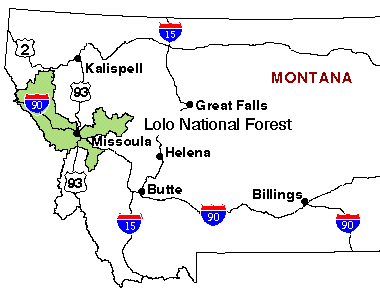
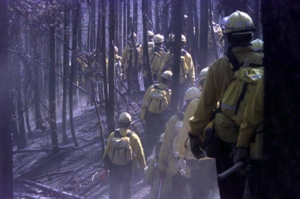 TF Lumberjack constructed almost 12 miles of fire line by hand through
extremely mountainous terrain. The teams patrolled, reinforced, cleared,
and mopped up nearly 75 miles of dozer line; burned out dozens of acres of
fuels; extinguished scores of spot fires that slopped over the fire line;
cleared hundreds of "snags" (dead trees); and completed many other
supporting tasks. Their efforts saved dozens of homes, ranches, and
businesses in the Nine Mile Valley and thousands of acres of forest. The
Task Force redeployed to Fort Hood on 10 September 2000.
TF Lumberjack constructed almost 12 miles of fire line by hand through
extremely mountainous terrain. The teams patrolled, reinforced, cleared,
and mopped up nearly 75 miles of dozer line; burned out dozens of acres of
fuels; extinguished scores of spot fires that slopped over the fire line;
cleared hundreds of "snags" (dead trees); and completed many other
supporting tasks. Their efforts saved dozens of homes, ranches, and
businesses in the Nine Mile Valley and thousands of acres of forest. The
Task Force redeployed to Fort Hood on 10 September 2000.
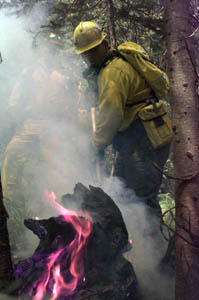 This was a great mission in many ways. The 20th Engineer Battalion
staff planned a deployment from home station with little notice. The unit linked
up with 34 professional firefighters-advisors, from various federal agencies,
and began training while still at Fort Hood. Upon deployment, the advisors
provided three more days of fire line training, but really the training
never stopped. The advisors were constantly with the task force on the fire line.
This was a huge force multiplier. The advisors stressed safety, proper
firefighting techniques, and effective communications. The soldiers of Task Force Lumberjack learned terms
like "cat lines," "spike camps," "coyote tactics," "burnout," "torching,"
"hose lay," etc.
This was a great mission in many ways. The 20th Engineer Battalion
staff planned a deployment from home station with little notice. The unit linked
up with 34 professional firefighters-advisors, from various federal agencies,
and began training while still at Fort Hood. Upon deployment, the advisors
provided three more days of fire line training, but really the training
never stopped. The advisors were constantly with the task force on the fire line.
This was a huge force multiplier. The advisors stressed safety, proper
firefighting techniques, and effective communications. The soldiers of Task Force Lumberjack learned terms
like "cat lines," "spike camps," "coyote tactics," "burnout," "torching,"
"hose lay," etc.
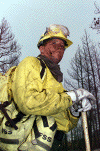 When the advisors told the soldiers that their "Type II Plus" crews
cut line through terrain usually reserved for "Type I" Hotshot or Smoke Jumper
crews, it became a source of great pride and motivation for the soldiers.
When the advisors told the soldiers that their "Type II Plus" crews
cut line through terrain usually reserved for "Type I" Hotshot or Smoke Jumper
crews, it became a source of great pride and motivation for the soldiers.
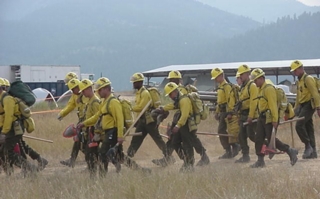 The mission provided excellent small unit leadership training in a
challenging environment. Junior officers and NCOs took charge. It was
tough, physical labor using hand tools such as "Pulaskis" (a kind of half
axe - half mattock), shovels, hoses, pumps, and other tools. NCOs conducted
pre-combat checks and inspections on tools and equipment, checked soldiers' feet and health, and
coordinated work details. Officers coordinated with civilian firefighting
experts to ensure effective team utilization. Some soldiers took an
intensive three-day chainsaw operation course. Soldiers and leaders
developed close-knit teams as they accomplished a satisfying and important
mission.
The mission provided excellent small unit leadership training in a
challenging environment. Junior officers and NCOs took charge. It was
tough, physical labor using hand tools such as "Pulaskis" (a kind of half
axe - half mattock), shovels, hoses, pumps, and other tools. NCOs conducted
pre-combat checks and inspections on tools and equipment, checked soldiers' feet and health, and
coordinated work details. Officers coordinated with civilian firefighting
experts to ensure effective team utilization. Some soldiers took an
intensive three-day chainsaw operation course. Soldiers and leaders
developed close-knit teams as they accomplished a satisfying and important
mission.
Working alongside a civilian Incident Command Post (ICP) proved to be both a blessing and a challenge. Lt. Col. Shumway said it was much like working in a coalition headquarters. "These civilian firefighters and support personnel were exceptionally professional in what they do. Most were extremely supportive." However, many had never worked with the military before and the ICP staff turned over several times during the four-week mission, which added to the turbulence. The Incident Command System (ICS) shows many similarities to a military command and control system and is largely compatible. According the Lt. Col. Shumway, the differences, usually subtle, could be frustrating.
The ICP headquarters included operations, administrative, and logistics personnel. The ICP even had intelligence experts known as "fire behavior specialists" and meteorologists. Their orders, while lengthy, contained substance and a generally useful format. The ICP issued operational graphics with their orders. Task Force Lumberjack quickly learned to work within ICS and developed a functional battle rhythm, useful orders, and solid communications. Establishing habitual relationships between civilian superintendents and military fire crews helped build confidence and increased understanding. Usually after only a couple of days, operations smoothed out.
The Task Force commander, Lt. Col. Shumway maximized opportunities to enhance his unit's own military capabilities, using the deployment as an "operational" exercise. His command learned many lessons about public affairs, coordinating aviation operations with civilian agencies, predeployment training, preparation, and coordination. The task force included MEDEVAC helicopters that flew both training and actual missions. Other Black Hawk aircraft flew reconnaissance and command and control (C2) missions. The staff feld they could have flown more troop shuttle missions and logistics missions if not for bureaucratic red tape. Fortunately, NIFC listened when they suggested improvements. NIFC held a conference on lessons learned that should lead, in the future, to streamlined aviation and other procedures.
The Lumberjack air load planners and pallet building teams prepared the unit to fly on USAF aircraft. A dedicated 5th Army liaison officer (LNO) facilitated coordination with the National Interagency Fire Center and various other agencies.
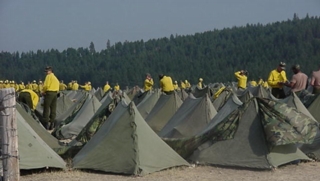 Despite soldiers sleeping in shelter halves, living conditions were
hardly austere. Food service and shower facilities were excellent. There
was a mobile AAFES PX, a laundry with 24-hour turn-around, and other
facilities. After 14 days of exhausting work, company size units got one
day of R&R to watch a movie, take a sightseeing trip, go shopping, or just
relax.
Despite soldiers sleeping in shelter halves, living conditions were
hardly austere. Food service and shower facilities were excellent. There
was a mobile AAFES PX, a laundry with 24-hour turn-around, and other
facilities. After 14 days of exhausting work, company size units got one
day of R&R to watch a movie, take a sightseeing trip, go shopping, or just
relax.
As the mission progressed, soldiers were invited to football games, a Willie Nelson Concert, and other events. Local schools sent cards. Kids brought cookies. The Governor of Montana and local officials visited and offered their thanks. Newspapers published articles and TV stations interviewed individual soldiers as well as the leaders.
 Serving on a mission where the results were so evident and the
appreciation of the public so deeply felt was very rewarding for the
soldiers who participated. In expression of gratitude for support to the citizenry, the participants of Task Force Lumberjack were awarded the Humanitarian Service Medal. Many local citizens expressed their thanks with
a sign in their yard, or fresh cookies delivered with a tear in the eye. It
was not something the soldiers of TF Lumberjack will soon forget.
Serving on a mission where the results were so evident and the
appreciation of the public so deeply felt was very rewarding for the
soldiers who participated. In expression of gratitude for support to the citizenry, the participants of Task Force Lumberjack were awarded the Humanitarian Service Medal. Many local citizens expressed their thanks with
a sign in their yard, or fresh cookies delivered with a tear in the eye. It
was not something the soldiers of TF Lumberjack will soon forget.
Special thanks to Lt. Col James Shumway, who provided the bulk of information on this page.